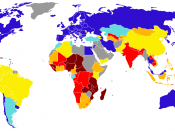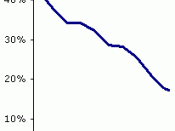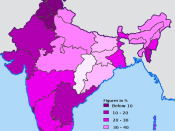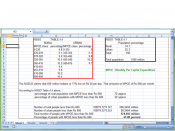The first table of the World Bank's World Development Report 2000/2001: Attacking Poverty shows that the number of people living on less than $1 a day grew from 1.18 billion in 1987 to 1.20 billion in 1998-an increase of 20 million. Less than two years later, a headline chart in another major World Bank publication, Globalization, Growth, and Poverty: Building an Inclusive World Economy, showed that the number of people living in poverty fell by 200 million from 1980 to 1998 and showed no trace of an increase between 1987 and 1998. The poverty decrease was reaffirmed in the press release accompanying "The Role and Effectiveness of Development Assistance," a World Bank research paper issued before the March 2002 UN Financing for Development Conference in Monterrey, Mexico: "Over the past 20 years, the number of people living on less than $1 a day has fallen by 200 million, even as the world's population grew by 1.6
billion." Can these statements be reconciled? Has there been a marked reduction in poverty in the last two years? Or has the Bank revised its interpretation of history? Getting an accurate poverty count is important. The Bank sails under the banner "Our dream is a world free of poverty," which not only invites the use of the poverty count as a measure of the extent to which the dream is being fulfilled but also raises the issue of whether the organization's success can be convincingly measured by its own numbers. We also need an accurate poverty count to assess whether the international community is achieving one of the Millennium Development Goals endorsed by 189 countries at the September 2000 UN Millennium Summit-to "halve, between 1990 and 2015, the proportion of people whose income is less than one dollar a day." A lot depends on whether the scorecard is being credibly tallied, and the apparent discrepancies in the Bank's numbers deserve serious scrutiny. That scrutiny produces some genuinely good news about poverty declining but also raises some serious concerns about the numbers. With respect to the production of data, still greater transparency on the Bank's part is called for.
Poverty in India Take the case of India. Its poverty counts are important not only because they have a large direct effect on world poverty counts-more than one-fourth of the world's poor live in India-but also because the world debate on globalization, poverty, and inequality has been echoed in an intense domestic debate.
India's economic liberalization in the early 1990s was followed by historically high rates of growth. But did this growth help or hurt the poor? Were their numbers reduced or did economic growth benefit only an increasingly wealthy urban elite? The political debate has been fueled by questions about the accuracy of poverty measurements in light of the discrepancies between estimates of consumption growth based on national accounts statistics (NAS) and those based on household surveys carried out by the National Sample Survey (NSS). According to the NAS, real per capita consumption has been growing at about 3.2 percent a year since the reforms, while, at least until recently, the NSS data have shown little or no growth throughout the 1990s. Reform opponents resolutely quote the NSS data, while reform advocates back the NAS growth estimates, questioning the accuracy and the integrity of the NSS data and arguing that, because the poor's share of the national pie is more or less fixed, growth must reduce poverty.
The controversy only deepened last year with the release of the 1999-2000 consumption survey, the first major survey since 1993-94, when reforms had barely begun to take effect. In the intervening years, there had been a series of smaller ("thin") household surveys showing little or no growth in per capita consumption and, if anything, a rise in poverty. Accurate or not, they provided the only numbers in town and were widely used outside India-for example, in the World Bank's Attacking Poverty, albeit with due acknowledgment of uncertainty. Hence the belief that poverty in India had been increasing.
Unfortunately, in a decision whose timing could hardly have been worse, the NSS made major changes to the questionnaire design for the 1999-2000 survey. Although the new survey design is sensible in itself, it is not comparable with earlier designs and almost certainly leads to more consumption being reported, especially among the poor. As a result, measured poverty was lower than it would have been with the previous design. So when the Planning Commission issued its poverty estimates in February 2001, showing a dramatic fall in poverty-from 36 percent of the population to 26 percent-many cried foul. Pleas to have the survey redone to make it consistent with earlier surveys were ignored, and the ruling Bharatiya Janata Party was in no hurry to challenge estimates that showed rapid progress in dealing with India's most intractable and longstanding social and economic problem.
The chart shows the official estimates (the planning-commission head-count ratios) going back to 1973-74; each circle comes from a large consumption survey. The points labeled "thin" rounds show the (unofficially calculated) poverty estimates from recent smaller surveys. If the final point is blanked out, we can imagine the situation immediately prior to February 2001. From that perspective, the 1999-2000 estimate is nothing short of astonishing: the Indian poverty rate fell by 12.8 percent over 18 months, removing 60 million persons from poverty. Progress indeed! Over the past year or so, I and others have been working with the data to try to sort out what happened. Although the questionnaire design was changed for most of the goods in the survey, data on an important group of expenditures were collected in the same way in all of the surveys. Fortunately, nearly all households purchase these goods, and the total amount they spend on them is a good predictor of whether a household is poor or not. The latest data show a marked increase in real expenditures on these goods, which indicates a substantial reduction in poverty overall. The extent of the increase also allows us to estimate how much poverty has fallen. Much to my surprise, most of the officially claimed reduction in poverty appears to be real. I estimate that poverty fell from 36 percent in 1993-94, not to 26 percent as in the official numbers, but to 28 percent. These calculations, although necessarily speculative, are supported by analysis carried out by K. Sundaram and Suresh Tendulkar at the Delhi School of Economics, who obtain very similar results using entirely different methods.
Another complication is the questionable quality of the Indian price indexes used to update the poverty lines. With some correction to the price indexes, as well as an allowance for the noncomparable survey design, the head-count ratio shows a fairly steady decline from 1987-88 through 1999-2000. Indeed, since the 1970s India has made more or less steady progress in reducing poverty. (The "fully adjusted" estimates in the figure also correct for overestimation of urban poverty in the official counts, and thus start from a lower base in 1987-88.) Even so, the estimates based on the "thin rounds" raise unanswered questions. Although the last of these, which is the most egregious, is relatively easy to challenge-if only because the survey ran for only six months-there is at present no obvious reason to dismiss the three earlier observations.
Can we conclude that the reforms helped reduce poverty? Neither consumption growth nor poverty reduction shows much sign of having been more rapid after the reforms. But neither is there any sign of general impoverishment as a result of the reforms-indeed, quite the reverse. What about inequality? Again, the change in survey design precludes any simple, uncontroversial answer. But the adjustment procedures applied to the poverty counts can also be used to estimate inequality, which has been increasing in recent years, particularly between states-the states in the south and west that were originally better off have grown most rapidly-as well as within urban areas, which have been the greatest beneficiaries of growth.
Because of this growing inequality, consumption by the poor did not rise as fast as average consumption, and poverty reduction was only about two-thirds of what it would have been had the distribution of consumption remained unchanged.





